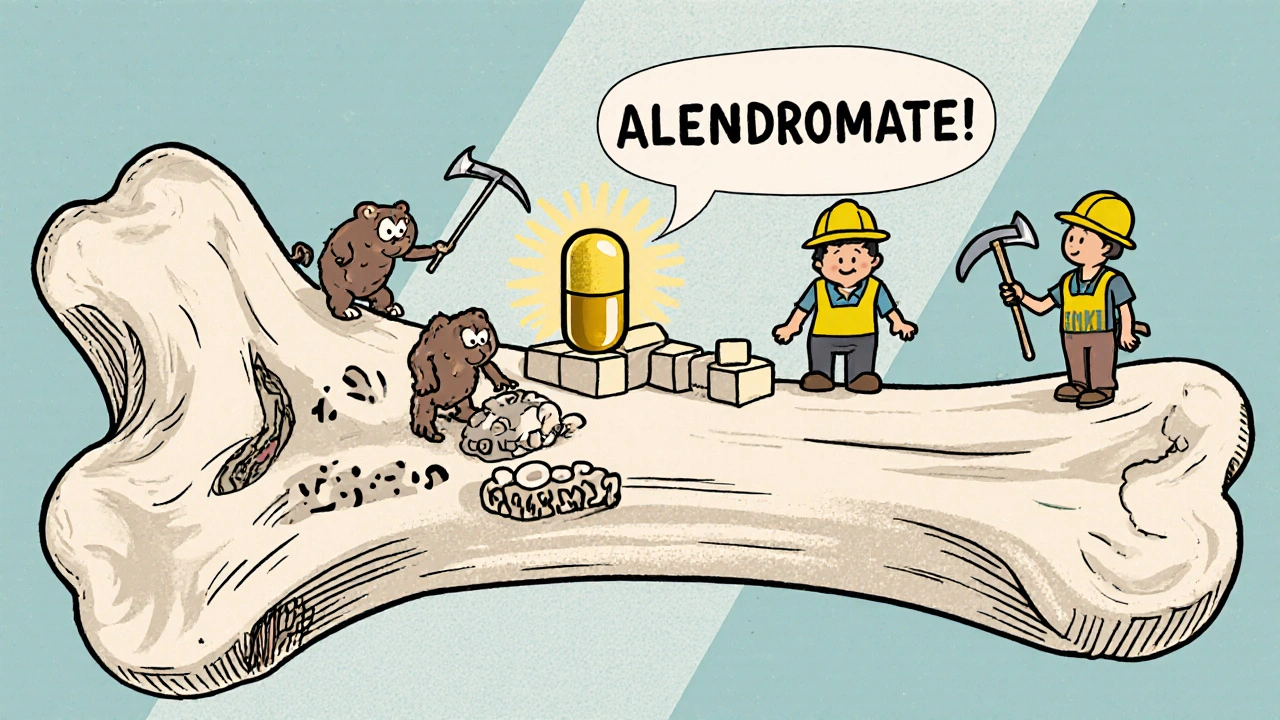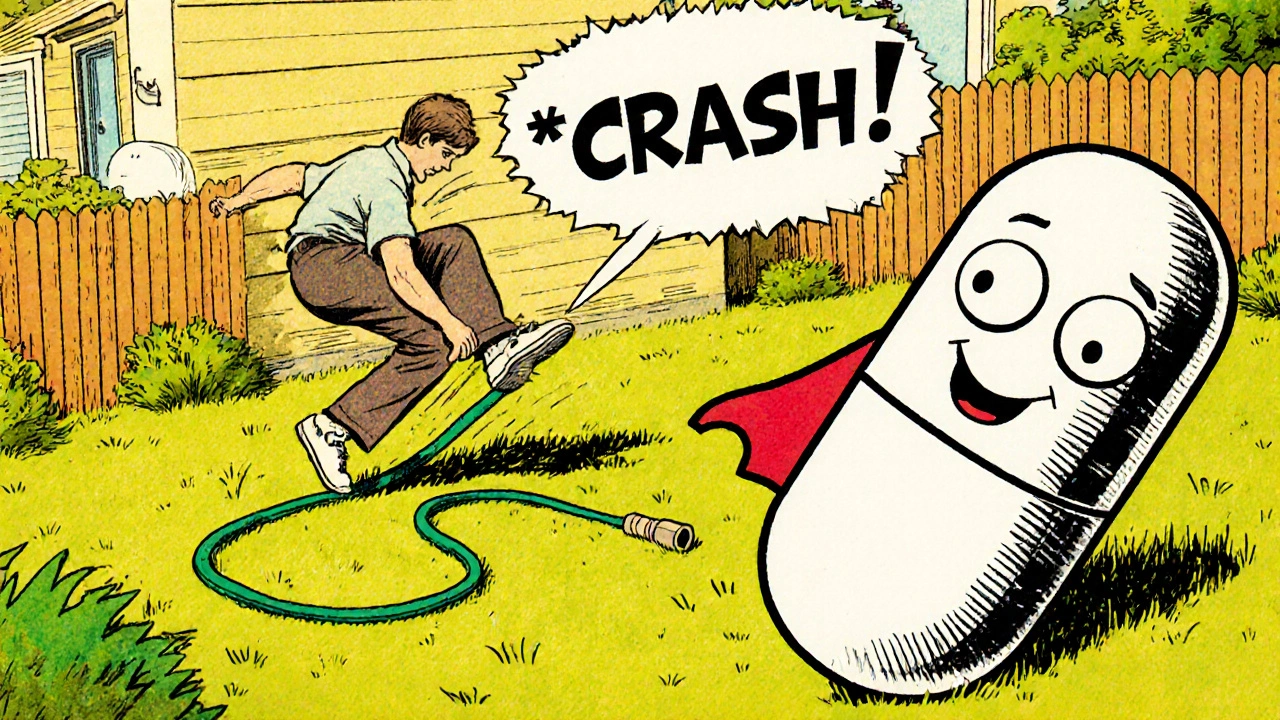Fracture Risk Reduction Calculator
Understand Your Risk Reduction
Based on clinical evidence from the Fracture Intervention Trial, estimate how alendronate may reduce your fracture risk.
Your Estimated Risk Reduction
Current Risk:
$0.0%
Estimated Reduction:
$0.0%
With alendronate therapy, your vertebral fracture risk would be reduced by 44% based on clinical evidence.
Imagine stumbling over a garden hose and shattering a hip that should have stayed strong. For millions with weak bones, that isn’t a nightmare - it’s a daily risk. One drug that has reshaped that reality is alendronate, a pill that quietly strengthens the skeleton and slashes fracture rates.
What Is Alendronate?
Alendronate is a bisphosphonate medication approved to treat and prevent osteoporosis. It works by slowing down the cells that break down bone, giving the body a chance to rebuild stronger tissue. First approved by the FDA in 1995, it has become a frontline option for anyone at risk of bone fractures.
Why Bone Fractures Matter
When bone density drops below a critical threshold, even a minor bump can cause a break. According to the World Health Organization, osteoporosis affects roughly 200 million people worldwide, and fractures account for the majority of related hospitalizations and costs.
How Alendronate Prevents Fractures
To grasp its impact, we need a quick refresher on bone remodeling. The skeleton is a living tissue that constantly renews itself through two opposing processes:
- Bone Resorption - carried out by osteoclasts, which dissolve old bone.
- Bone Formation - driven by osteoblasts, which lay down fresh matrix.
In osteoporosis, resorption outpaces formation, leaving porous, fragile bone. RANKL (Receptor Activator of Nuclear Factor κB Ligand) is a protein that tells osteoclasts to get to work. Alendronate binds to tiny mineral spots on bone surface, and when osteoclasts try to eat that spot, the drug disrupts their activity, effectively muting RANKL’s signal.
The result? A slower turnover rate, higher bone mineral density (BMD), and a sturdier scaffold that can better withstand everyday stresses.
Clinical Evidence: Numbers That Speak
Large-scale studies have quantified alendronate’s benefit. In the pivotal Fracture Intervention Trial (FIT), post‑menopausal women taking 10 mg daily saw:
- 44% fewer new vertebral fractures
- 30% reduction in hip fractures
- 28% drop in non‑vertebral fractures (including wrist and humerus)
Follow‑up data up to 10 years confirm that the gains in BMD are maintained, provided patients stay adherent.

Who Should Consider Alendronate?
Guidelines from the National Osteoporosis Foundation (NOF) recommend alendronate for:
- Post‑menopausal women with a T‑score ≤ -2.5
- Men over 50 with confirmed low bone density
- Anyone who has already suffered a fragility fracture
- Patients on long‑term glucocorticoids (≥5 mg prednisone daily for ≥3 months)
If you fit these criteria, a conversation with your clinician is a solid next step.
Dosage Options and Administration Tips
Alendronate comes in two common formats:
- 10 mg tablet taken once daily
- 70 mg tablet taken once weekly (often preferred for convenience)
Key rules to maximize absorption and reduce stomach irritation:
- Take the pill with a full glass (8 oz/240 ml) of plain water.
- Swallow it upright - no lying down for at least 30 minutes.
- Take it on an empty stomach, first thing in the morning, at least 30 minutes before food, coffee, or other meds.
Missing a dose? If it’s been less than 12 hours, take it as soon as you remember, then resume your regular schedule. Longer gaps require a fresh start with the “empty‑stomach” routine.
Safety Profile: What to Watch For
Most people tolerate alendronate well, but a few side effects are worth noting:
- Upper‑body gastrointestinal irritation (heartburn, nausea) - often mitigated by the administration tips above.
- Rare esophageal ulceration - report persistent chest pain or difficulty swallowing.
- Transient flu‑like symptoms after the first dose (muscle aches, fever) - usually fade after a few days.
- Long‑term risk of atypical femoral fractures and osteonecrosis of the jaw (ONJ). These are very uncommon (<0.001%); dental health checks before starting therapy help keep the risk low.
Patients with severe kidney disease (creatinine clearance < 30 ml/min) should avoid oral bisphosphonates and explore alternatives like intravenous zoledronic acid.
Supporting Alendronate With Nutrition
Bone health isn’t just a pill; it’s a partnership between medication and lifestyle. Two nutrients consistently shown to boost alendronate’s effect are:
- Calcium - aim for 1,200 mg/day from diet or supplements.
- Vitamin D - keep serum 25‑OH levels between 30‑50 ng/ml; 800-1,000 IU daily is typical.
Regular weight‑bearing exercise (walking, resistance training) further reinforces bone density gains.
Alendronate vs. Other Bisphosphonates
| Attribute | Alendronate | Risedronate |
|---|---|---|
| Typical Dose | 10 mg daily or 70 mg weekly | 35 mg weekly |
| FDA Approval Year | 1995 | 1998 |
| Common GI Side Effects | Heartburn, nausea | Stomach pain, dyspepsia |
| Cost (US, 30‑day supply) | ≈ $15 (generic) | ≈ $20 (generic) |
| Fracture Risk Reduction (Hip) | ~30% | ~28% |
Both drugs share the same mechanism, but dosing convenience and price can tip the balance for individual patients.
Checklist: Making the Most of Alendronate Therapy
- Confirm diagnosis with a DXA scan (T‑score ≤ -2.5).
- Discuss any history of esophageal disorders or kidney disease with your doctor.
- Set up a morning routine: water, pill, stay upright 30 min.
- Schedule a dental exam before starting; maintain good oral hygiene.
- Track calcium and vitamin D intake; consider supplements if diet falls short.
- Arrange yearly follow‑up DXA to evaluate BMD changes.
- Report persistent throat pain, new thigh pain, or jaw soreness promptly.
Frequently Asked Questions
Can I take alendronate if I have a stomach ulcer?
Generally, it’s not recommended. The medication can irritate the lining of the esophagus and stomach. Your doctor may suggest a different bisphosphonate formulation or an IV option.
How soon will I see an improvement in bone density?
Most patients notice a measurable BMD increase after about 6-12 months of consistent use, though fracture risk reduction can start earlier, within the first year.
Is it safe to take calcium supplements together with alendronate?
Yes, but keep a 30‑minute gap. Take alendronate first with water, then wait before consuming calcium or vitamin D.
What should I do if I miss a weekly dose?
Skip the missed dose and resume the regular weekly schedule. Do not double up, as a higher dose can increase GI irritation.
Can alendronate be taken during pregnancy?
No. Bisphosphonates are classified as pregnancy‑category X because they can affect fetal bone development. Women planning pregnancy should discuss alternative treatments.
Why do some patients experience flu‑like symptoms after the first dose?
The temporary immune response is thought to arise from the drug’s interaction with bone‑lining cells. It usually resolves within a few days and does not require stopping the medication.
Bottom Line: Is Alendronate Right for You?
If you’ve been warned about a fragile skeleton, alendronate offers a proven, cost‑effective way to keep fractures at bay. Pair it with calcium, vitamin D, and regular weight‑bearing activity, and you’ve built a three‑part defense against bone loss. As always, start a conversation with your healthcare provider to tailor the plan to your health history.






Comments
Listen up, folks – alendronate is not just another pill, it’s a game‑changer for anyone battling bone loss. In my community we see too many elders breaking hips over the simplest chores, and this drug can cut that risk dramatically. Take it as prescribed, follow the empty‑stomach rules, and watch your bone density climb. Don’t let pharma myths keep you from a stronger skeleton.
The article drags on forever for a simple drug.
Great overview – the FIT numbers really drive the point home, and the administration tips are spot on.
When we consider bone as the architecture of our bodies, alendronate becomes the silent mason reinforcing the hidden foundations. The balance between osteoclasts and osteoblasts mirrors the eternal dance of creation and decay. By tempering the resorption, we grant the builder more time to craft sturdy structures. It’s a subtle reminder that even chemistry can echo the poetry of life.
Imagine the sound of a fragile bone snapping – you hear it in the silent corridors of every hospital. Alendronate swoops in like a heroic cavalry, turning that tragic clang into a hopeful hum. The data from the FIT trial isn’t just numbers; it’s a chorus of saved lives. Follow the simple regimen and you’ll be part of that triumphant saga.
Alendronate paints a vibrant picture of bone fortification, swapping frailty for resilience with each dose. The weekly 70 mg tablet feels like a secret weapon, quietly defending hips and spines. Embrace the regimen and let your skeleton wear its new armor proudly.
I find the breakdown of bone remodeling clear and helpful, and the dosage tips are easy to remember.
Wait-did you really think that pharma companies just handed us alendronate out of kindness??? They hide the real risks behind glossy studies!!! The government agencies are in cahoots, and the “safe” profile is a marketing illusion!!!